Poison Ivy

Poison ivy and other similar plants can cause an allergic reaction which results in a itchy rash. The plant is characterized by its three leaf pattern which can be remembered by the phrase, “Leaves of three, let it be”. However, poison ivy is not the only North American plant which can give you an allergic reaction.
Plant Varieties
There are several closely related plants found in North America that can give you an allergic reaction.
- Poison Ivy – Characterized by its three leaf pattern and hairy vine
- Poison Oak – A small shrub that produces white berries
- Poison Sumac – Branches lined with two rows of leaves and produces green or white berries
If you suspect that you have come into contact with poison ivy, poison oak, or poison sumac, immediately wash the affected area with rubbing alcohol or soap and cold water.
Causes of Rashes
Poison Ivy, Oak, and Sumac plants contain an oil, Urushiol, that is extremely irritating to the skin. It may be brushed onto the clothing or skin of people coming in contact with the plants. The only way that you can have an allergic reaction is is you come into contact with the oil that these plants produce.
People with rashes from poison ivy, poison oak, or poison sumac are not contagious. This means that coming into contact with an affected person’s blisters will not cause you to develop rashes.
Symptoms
Common symptoms of exposure to poison ivy, poison oak or poison sumac are usually characterized by the following:
- Severe itching of the skin
- Red streaks or general redness where skin to plant contact occurred
- Small bumps or hives
- Blisters that may or may not leak fluid
If you feel you have symptoms of poison ivy, oak, or sumac, we recommend scheduling an appointment with us today. Our board certified dermatologist, Dr. Mary Noël George, will review condition and prescribe treatment options if necessary.
Treatment
At George Dermatology, we generally treat poison ivy, oak, or sumac rashes with lotions and oral antihistamines. Depending on the severity, we may need to prescribe oral steriods. Granted, treatment is dependent on your individual symptoms and medical history.
Do You Suffer From Itchy Red Rashes Resulting From Poison Ivy, Oak, or Sumac?
Make sure that you get the right treatment for your rash in order to limit long term damage to you and your skin. Set up an appointment with our board certified dermatologist today.
